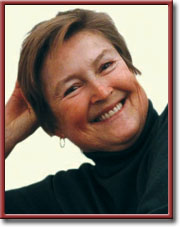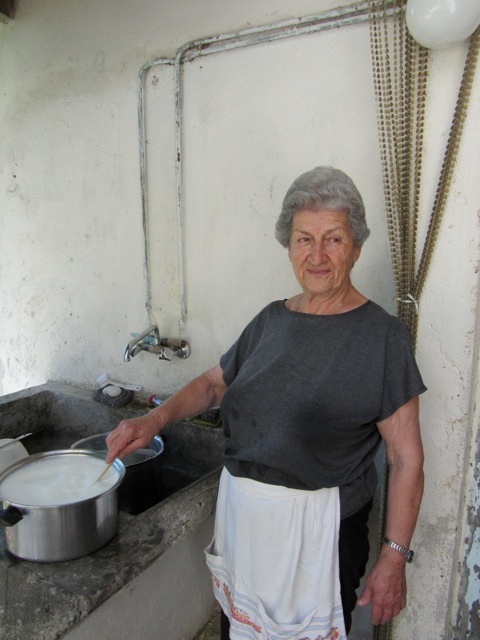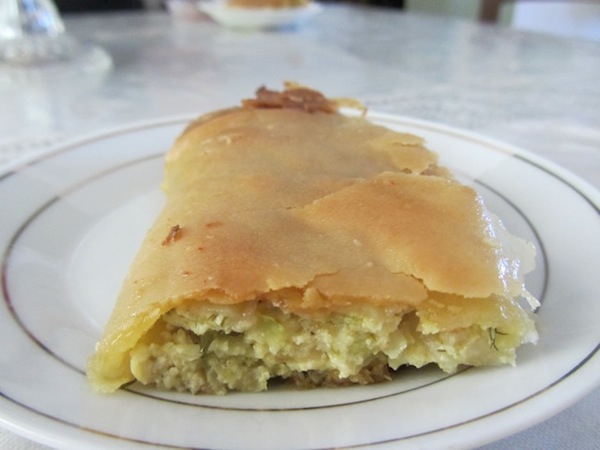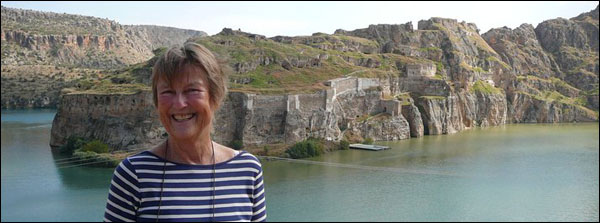Back To The Future In Evia: Village Life In The 21st Century
“This is the Greece we fell in love with, Annie and I, so many decades ago. And, guess what? It’s still here. My bet is that no matter what happens after our (next) election day on June 17th, these enduring values of hospitality, humor, generosity, and neighbourliness, in the best sense, will be even more evident and we won’t have to look so hard to find them.” Diana Farr Louis
Eating Well Is The Best Revenge
by Diana Farr Louis
 ATHENS Greece—(Weekly Hubris)—6/18/2012—I’m not a jealous person by nature. I don’t covet greener pastures, other women’s husbands, or even other people’s money . . . though I do occasionally wish I’d ordered my dining companion’s dish.
ATHENS Greece—(Weekly Hubris)—6/18/2012—I’m not a jealous person by nature. I don’t covet greener pastures, other women’s husbands, or even other people’s money . . . though I do occasionally wish I’d ordered my dining companion’s dish.
But, last weekend, I truly coveted my friend Annie’s community on Evia (or Euboea, for you classicists: http://en.wikipedia.org/wiki/Euboea).
Evia, Greece’s second largest island after Crete, often evinces a scornful yawn because those who don’t know it call it a non-island. It parallels the eastern mainland so closely that you can actually cross over to its middle by bridge. (Anyone who’s been marooned by foul weather on a more distant island might actually see the advantages of car over ferry.) It has high mountains, lovely beaches, Venetian castles, and not too much tourism. Andros has all that too, but those are not the things I miss.
Annie Apgar lives in a village. I never wanted that before. Foreign cooking smells and loud music, people’s prying eyes, gossip, neighbors popping in unannounced—gave me the heebie jeebies. I love my wide open spaces on Andros, the bleating and baaing of our co-inhabitants next door, the view down the valley to the sea and beyond to the islands of Kea, Kythnos and, on a clear day, several more. From higher spots we can even see the green flanks and steep ridge of Evia, crowned by Mt. Ohi, where Zeus and Hera were thought to have wed.
We can’t see as far as Annie’s village, Raptei, but it is not one of those photogenic arrangements of sugar cubes on a tawny slope. It would never win an award for its architecture. Red tiles have replaced most of the beautiful old local slate roofs. Several houses droop empty and neglected. Some have been shored up with ugly cement.
In short, it resembles many villages throughout Greece in being quite ordinary.
On the other hand, Raptei is so awash in greenery that you barely see the houses, even the ones next door. Cypresses, olives, figs, mulberries, and shocking-pink oleanders fill the view all the way to the sea. And each house looks down or up on its own flourishing perivoli, or vegetable patch.
Even more than those gardens, it’s Annie’s neighbors who have awakened the green-eyed monster inside me. What wouldn’t I give to have a Sophia and a Mina in my life.
I’d heard about Sophia Eleftherou—whom Annie calls Sophie—for years. Annie mentions her strength and humor, her kindness, her cooking, and her dexterity with the rolling pin almost every time she comes into Athens. Now I was finally going to meet her.
Annie leads me a few steps down her street and opens a gate onto a broad terrace lined with potted plants. We pad across it to a staircase leading to Sophie’s work area. Although she has a spacious kitchen with an electric stove and all “mod cons”—UK slang for Modern Conveniences—Sophie does most of her serious cooking in a tiny closet-like room over a gas-powered hub with two-burners. And sometimes even in the adjoining fireplace. We peer into the room, large enough for one person, and there she is, stirring two pots, one filled with simmering sheep’s milk for yogurt, the other bubbling with frothy apricots for jam.

“Here’s my friend, Diana,” says Annie.
Sophie, an erect figure in a loose dark dress, turns away from her pots and sizes me up coolly. “You’re the one that kanei cookbooks?”
After 20 years in Sydney, but 39 years since her return, Sophie’s in her late 70s but still speaks pretty good English. She and Annie, who’s a Kiwi, speak a Greeklish patois that flows naturally.
When I reply in the affirmative; her serious almost stern face breaks into a welcoming smile. But then she sobers up again: “You should have come earlier, you’ve missed the pita. I’ve been up since 6, weeded the perivoli, rolled out the fyllo, baked the pie, and when I finish with this yogurt, I’ll be done for the day.”
While she’s stirring, Annie shows me around: the ancient oven, with its black halo, squatting on top of the empty chicken coop; the patches of corn, tomatoes, and zucchini; a small olive grove where chickens are pecking at the earth; an outdoor sink; and a couple of storerooms, where Sophie displays her fyllo-making skills to groups of foreigners who join Annie and her fellow Kiwi, Jude Collins, on Culture and Cuisine Tours of Evia (http://www.cultureandcusineinevia.com/) in spring and fall.
These performances are legendary but, though it’s only 10:30, I’ve missed my chance. Instead, we try to drag the recipe for the kolokithopita (zucchini pie) out of Sophie. It’s clear she enjoys telling us, but slowly, on her own terms. And with spread fingers to indicate the size of the zucchini or the piece of cheese. When I ask if I can write about her and take her photo, she looks pleased, not falsely shy or overly modest: a person of dignity accepting recognition.
She then leads the way upstairs to the proper kitchen, which is clearly the main room of the house, and sits us down at a spotless, white-napped table with four chairs. Photos of lovely daughters, grandchildren, and a handsome, late husband stand out against the unadorned white walls.
Will we have quince spoon sweet or pita? Both, I say, shamelessly.
Why is it we expect such hospitality in Greece but so rarely offer it so spontaneously and naturally ourselves?
After Sophie presents us each with a saucer of glistening reddish quince strips studded with blanched almonds, she takes out the pie. Annie’s surprised; the pan contains four crispy cylinders instead of the usual full square. Each is made with a single sheet of homemade, hand-rolled fyllo and, as I bite into my portion, I realize it is quite simply the best I’ve ever tasted. It’s light and crunchy; so often homemade fill is too thick, too heavy, stodgy.
And the filling? Annie asks, “Do you put any onion?”
You’d have thought she’d suggested arsenic. Sophie wrinkles her straight aristocratic nose in disgust, “What, and ruin the taste? Onions and zucchini do not go together!”
I ask what sort of cheese she uses in another dish, zucchini fritters.
“Gouda.”
“But that’s not traditional,” I complain.
“We’re making our own traditions here,” retorts Sophie.
As we’re nibbling and chatting, another woman pushes the beaded curtain that fronts so many country doors here—they let in the air and keep out the flies. This is Mina Apostolou, whom Annie calls the village angel. “She’s always giving things to others, never saving anything for herself.” Younger than Sophie, with an unwrinkled smiling face under fluffy white hair, she comes bearing a couple of empty plastic yogurt buckets. This is the precious local “Tupperware,” always returned to the owner to be refilled or passed on to another neighbor.

After more talk and banter—the two girls love to tease each other—Annie and I drag ourselves away. We still have to fit in a swim before I depart. Annie offers to take Mina and Sophie another day. Annie may not make yogurt or pitas, but she often serves as the village chauffeur.
We’re out the gate when we hear Mina calling her. “Ela, Anna, come back, I forgot to give you your yogurt and eggs.”
“I still have some of the old yogurt.”
“Oh, throw it out. But don’t forget to give me back the container.”
This is the Greece we fell in love with, Annie and I, so many decades ago. And, guess what? It’s still here. My bet is that no matter what happens after our (next) election day on June 17th, these enduring values of hospitality, humor, generosity, and neighbourliness, in the best sense, will be even more evident and we won’t have to look so hard to find them.
Then I won’t have to be jealous any more.

Recipe
Zucchini-Cheese Pie/Kolokithopita
There’s no way I can teach you how to reproduce Sophie’s amazing fyllo pastry. But here’s another version from my cookbook, Feasting and Fasting in Crete. If you can’t bear the struggle, there is perfectly adequate “country-style” fyllo (strudel leaves or fine German pastry) in the frozen food sections of good supermarkets, even in the US (or so I think).
350 grams (2 1/2 cups) bread flour
1/2 teaspoon salt
about 180 ml (3/4 cup) warm water
2 tablespoons olive oil
Combine the flour and the salt in a mixing bowl and make a well in the center. Add the water and olive oil and work the flour into the liquid to make the dough. When all the flour is absorbed, knead the dough in the bowl, adding more flour or liquid as needed, for about 10 minutes. The dough should be elastic and smooth. Cover and leave to rest for at least an hour before using.
If you were Sophie, you have a long pole like a skinny broomstick instead of a rolling pin. You’d also have a round tabletop on stumpy legs that you’d set on a work surface to roll out your pastry. But an ordinary floured table will do.
Separate the dough into four balls and roll out as thin as possible. You’re going to make these pies as if they were strudel, so make them rectangular. And cover the dough balls with a cloth so they won’t dry out while you’re working.
The Filling
4 fresh free-range eggs
2 zucchinis, about 7-8 inches long
a slab of feta cheese about the same length as the zukes
chopped dill
and a handful of trahana, rustic pasta pellets made of soured milk and flour, to soak up the zucchini water
Grate the zukes into a colander, sprinkle with salt and allow to drain for 30 minutes. Squeeze dry with your hands.
Crumble the feta, beat the eggs, and mix them together with the grated zucchini, dill, and trahana. If you don’t have trahana, use raw rice or semolina.
Preheat the oven to 375°F/180°C.
Spread a quarter of the filling a couple of inches behind the short end of the pastry square and roll it the pastry over itself to the end, as you would a jelly roll (does anyone make those anymore?) or a strudel. Tuck the two ends underneath and press them down to seal. Brush the surface with a little olive oil and place, seam-side down in an oiled baking pan. Repeat until finished.
Bake the pies until the crust is golden brown, about 30 minutes. We ate ours piping hot but they’ll be delicious at any temperature, though probably not quite as good as Sophie’s was.


3 Comments
Anita Eveson-Peck
Bravo, Dianaki mou! I look forward to your next book!
xxxyour first and most faithful fan!
barbara kalmoutis
for a few minutes, I was with you and Annie, inhaling the scent and hearing the sounds of Greece, meeting your friends, eating that delicious food, THANK YOU, now I have to wash away the tears…and start the day ,here.
diana
Thank YOU, Anita & Barbara — it’s readers/friends like you that keep me going. Much love to you both, Diana